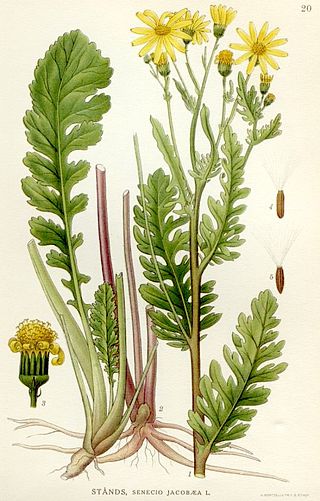
Jacobaea vulgaris, syn. Senecio jacobaea, is a very common wild flower in the family Asteraceae that is native to northern Eurasia, usually in dry, open places, and has also been widely distributed as a weed elsewhere.
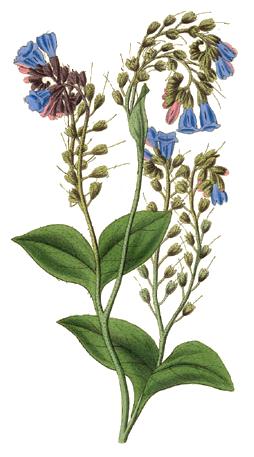
Symphytum is a genus of flowering plants in the borage family, Boraginaceae, known by the common name comfrey. There are 59 recognized species. Some species and hybrids, particularly S. officinale, Symphytum grandiflorum, and S. × uplandicum, are used in gardening and herbal medicine. They are not to be confused with Andersonglossum virginianum, known as wild comfrey, another member of the borage family.

Echium plantagineum, commonly known as purple viper's-bugloss or Patterson's curse, is a species of the genus Echium native to western and southern Europe, northern Africa, and southwestern Asia. It has also been introduced to Australia, South Africa, and United States, where it is an invasive weed. Due to a high concentration of pyrrolizidine alkaloids, it is poisonous to grazing livestock, especially those with simple digestive systems, such as horses.

Borage, also known as starflower, is an annual herb in the flowering plant family Boraginaceae. It is native to the Mediterranean region, and has naturalized in many other locales.

Tussilago farfara, commonly known as coltsfoot, is a plant in the tribe Senecioneae in the family Asteraceae, native to Europe and parts of western and central Asia. The name "tussilago" is derived from the Latin tussis, meaning cough, and ago, meaning to cast or to act on. It has had uses in traditional medicine, but the discovery of toxic pyrrolizidine alkaloids in the plant has resulted in liver health concerns.
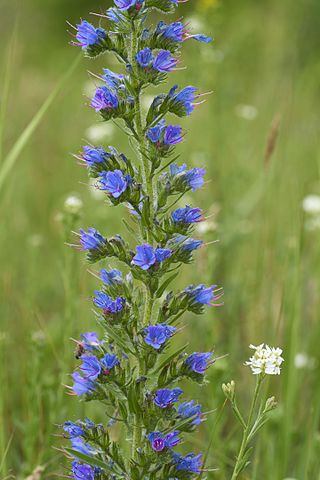
Echium vulgare, known as viper's bugloss and blueweed, is a species of flowering plant in the borage family Boraginaceae. It is native to most of Europe and western and central Asia and it occurs as an introduced species in north-eastern North America, south-western South America and the South and North Island of New Zealand. The plant root was used in ancient times as a treatment for snake or viper bites. If eaten, the plant is toxic to horses and cattle through the accumulation of pyrrolizidine alkaloids in the liver.

Eupatorium cannabinum, commonly known as hemp-agrimony, or holy rope, is a herbaceous plant in the family Asteraceae. It is a robust perennial native to Europe, NW. Africa, Turkey, Syria, Iran, Iraq, Jordan, the Caucasus and Central Asia. It is cultivated as an ornamental and occasionally found as a garden escape in scattered locations in China, the United States and Canada. It is extremely attractive to butterflies, much like buddleia.

Pyrrolizidine alkaloids (PAs), sometimes referred to as necine bases, are a group of naturally occurring alkaloids based on the structure of pyrrolizidine. Pyrrolizidine alkaloids are produced by plants as a defense mechanism against insect herbivores. More than 660 PAs and PA N-oxides have been identified in over 6,000 plants, and about half of them exhibit hepatotoxicity. They are found frequently in plants in the Boraginaceae, Asteraceae, Orchidaceae and Fabaceae families; less frequently in the Convolvulaceae and Poaceae, and in at least one species in the Lamiaceae. It has been estimated that 3% of the world’s flowering plants contain pyrrolizidine alkaloids. Honey can contain pyrrolizidine alkaloids, as can grains, milk, offal and eggs. To date (2011), there is no international regulation of PAs in food, unlike those for herbs and medicines.

Ageratum conyzoides is native to Tropical America, especially Brazil, and is an invasive weed in many other regions. It is an herb that is 0.5–1 m. high, with ovate leaves 2–6 cm long, and flowers are white to mauve.

Cynoglossum amabile, the Chinese hound's tongue or Chinese forget-me-not, is a species of flowering plant in the family Boraginaceae, native to Asia. A hardy annual growing to 50 cm (20 in), it has hairy leaves and cymes of sky-blue flowers in late summer. This plant, closely related to the common forget-me-not of temperate gardens, is also grown as an ornamental. In cultivation in the UK it has gained the Royal Horticultural Society’s Award of Garden Merit..

Emilia sonchifolia, also known as lilac tasselflower or cupid's shaving brush, is tropical flowering species of tasselflower in the sunflower family. It is widespread in tropical regions around the world, apparently native to Asia and naturalized in Africa, Australia, the Americas, and various oceanic islands.

Farfugium japonicum is a species of flowering plant in the family Asteraceae, also known as leopard plant, green leopard plant or tractor seat plant. It is native to streams and seashores of Japan, where it is called tsuwabuki (石蕗).

Symphytum officinale is a perennial flowering plant in the family Boraginaceae. Along with thirty four other species of Symphytum, it is known as comfrey. To differentiate it from other members of the genus Symphytum, this species is known as common comfrey or true comfrey. Other English names include boneset, knitbone, consound, and slippery-root. It is native to Europe, growing in damp, grassy places. It is locally frequent throughout Ireland and Britain on river banks and ditches. It occurs elsewhere, including North America, as an introduced species and sometimes a weed. The flowers are mostly visited by bumblebees. Internal or long-term topical use of comfrey is discouraged due to its strong potential to cause liver toxicity.
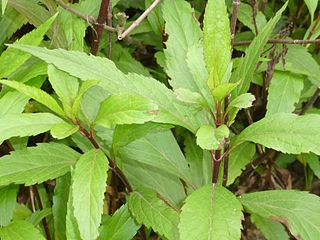
Eupatorium fortunei is a plant species in the family Asteraceae native from Asia where it is rare in the wild but commonly cultivated. The white to reddish colored flowers and herbage smell like lavender when crushed. In China the plants are used to make fragrant oils.

Heliotropium indicum, commonly known as Indian heliotrope, Indian turnsole is an annual, hirsute plant that is a common weed in waste places and settled areas. It is native to Asia. It is widely used in native medicine in Tamil Nadu, India.

Riddelliine is a chemical compound classified as a pyrrolizidine alkaloid. It was first isolated from Senecio riddellii and is also found in a variety of plants including Jacobaea vulgaris, Senecio vulgaris, and others plants in the genus Senecio.
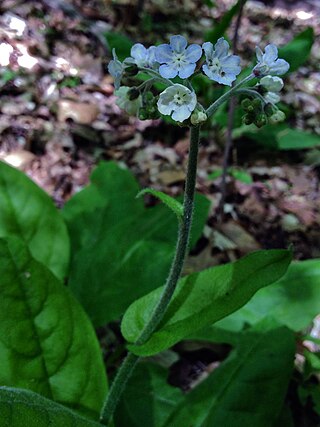
Andersonglossum virginianum, known as southern wild comfrey, is a flowering plant in the borage family native to North America. It is also sometimes called blue houndstongue.

Cynoglossum germanicum, the green houndstongue, is a flowering plant species, in the family Boraginaceae, which is native to Europe.
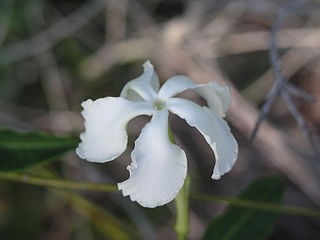
Echites umbellatus is a flowering climber, belonging to subfamily Apocynoideae of the family Apocynaceae and has the English common name devil's potato. It was first described in 1760 by Dutch botanist, Nikolaus Joseph von Jacquin. The species grows in parts of Florida, Tabasco, Yucatán Peninsula, Belize, Honduras, Cayman Islands, Cuba, Hispaniola, Jamaica, Leeward Islands, Bahamas, Turks and Caicos Islands, and the Colombian islands in the Western Caribbean.




















